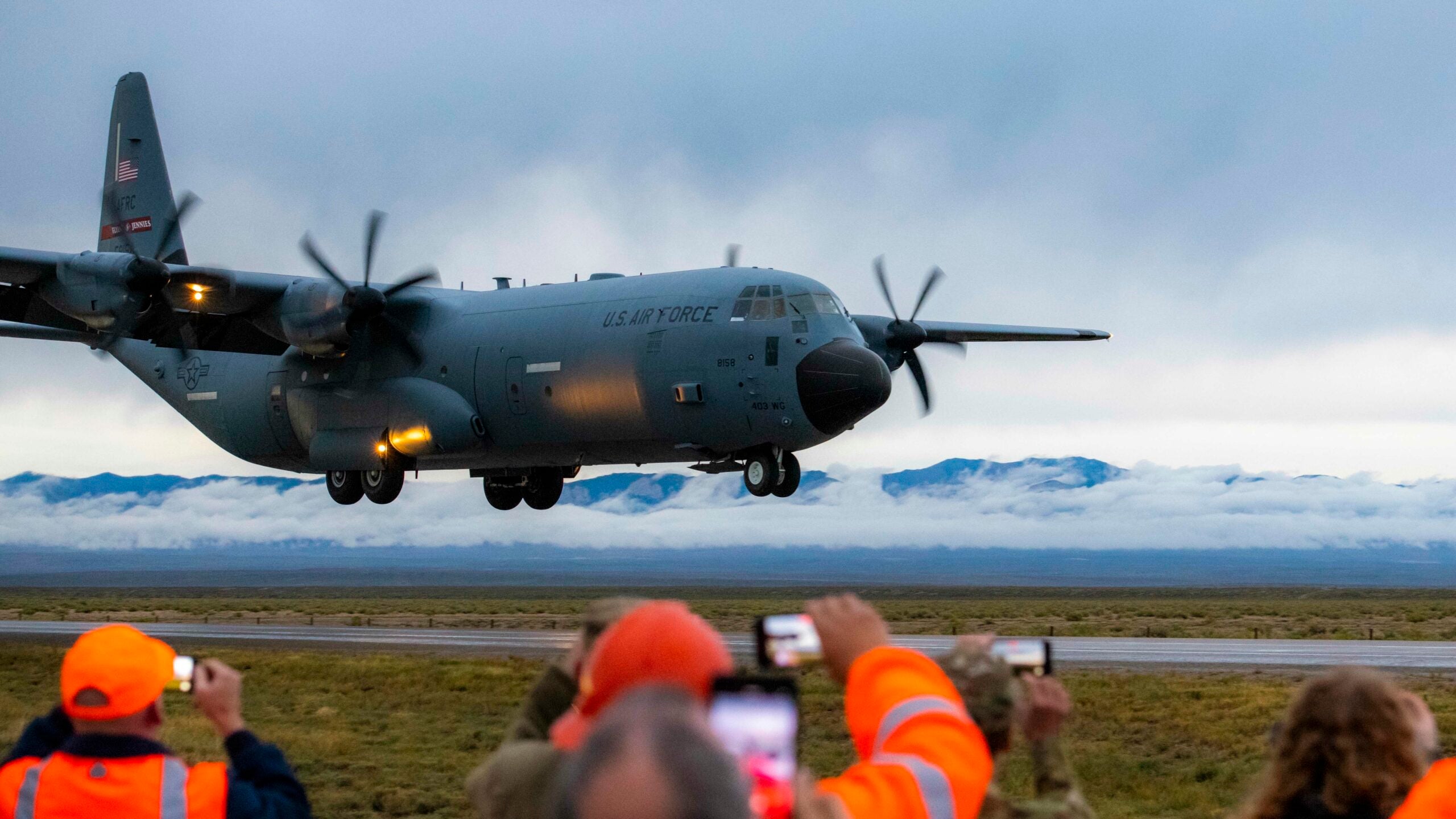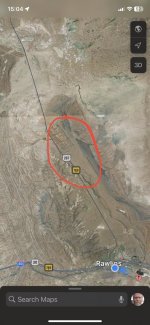SurvivalRing
Rich Fleetwood - Founder - author/coder/podcaster
A Wyoming highway closed for three hours so The Air Force could land planes on it

A Wyoming highway closed for three hours so The Air Force could land planes on it
The U.S. Air Force recently performed a rare military exercise in Southern Wyoming. They landed multiple aircrafts on remote U.S. highways 287 and 789 near Rawlins.
Wyoming Public Radio | ByWill Walkey
Published May 5, 2023 at 10:02 AM MDT

U.S. Air Force Photo By Tech. Sgt. Carly Kavish
/An A-10 Thunderbolt II “Warthog” lands on Highway 287 on April 30.
The U.S. Air Force recently performed a rare military exercise in Southern Wyoming. They landed multiple aircrafts on remote U.S. highways 287 and 789 near Rawlins.
Video shows a MC-130J Commando II landing on the empty road on a clear day in front of a mountainous vista. The plane is nearly 100 feet long and weighs 160,00 pounds, and it hit the asphalt at around 140 miles per hour.
The craft is designed to launch and land in remote locations without military-grade infrastructure. Several other planes and some helicopters also utilized Wyoming’s federal roads during the training.
It was the first time ever a military unmanned aerial drone – called an MQ-9 Reaper – landed on a highway.
rt-3:13
A commander in the air force said Wyoming was a good place to hold the training because of the state’s strong military community and the ability to create partnerships with local agencies to ensure a seamless and safe operation. Gov. Mark Gordon welcomed the exercise.
“Total Force training is an essential aspect of ensuring our military is always ready to respond to any crisis or situation that may arise,” he said in an interview. “Our state is well-positioned to support Total Force training exercises.”
Roads were closed for about three hours during the operation.
<><><><><><><><><><><><>

Highway 789 turned runway on May 2 - County 10™
(Riverton, WY) — History was made during Exercise Agile Chariot as an MC-130J Commando II, an MQ-9 Reaper, two A-10 Thunderbolt IIs and two MH-6 Little Birds landed on Highways 287 and 789 on April 30 and May 2, 2023, respectively. “The requirement here was clear: how do we get after Agile...
Highway 789 turned runway on May 2
Press ReleaseMay 3, 2023
 Members of the U.S. Army’s 160th Special Operation Aviation Regiment and U.S. Air Force’s 123rd Special Tactics Squadron participate in a search and rescue scenario as part of Exercise Agile Chariot, near Riverton, Wyoming, May 2, 2023. Agile Chariot tested Agile Combat Employment capabilities, including using smaller, more dispersed locations and teams to rapidly move and support aircraft, pilots, and other personnel to wherever they are needed. (U.S. Air Force photo by Senior Airman Natalie Fiorilli)
Members of the U.S. Army’s 160th Special Operation Aviation Regiment and U.S. Air Force’s 123rd Special Tactics Squadron participate in a search and rescue scenario as part of Exercise Agile Chariot, near Riverton, Wyoming, May 2, 2023. Agile Chariot tested Agile Combat Employment capabilities, including using smaller, more dispersed locations and teams to rapidly move and support aircraft, pilots, and other personnel to wherever they are needed. (U.S. Air Force photo by Senior Airman Natalie Fiorilli)
U.S. Air Force Photo By Tech. Sgt. Carly Kavish
/An A-10 Thunderbolt II “Warthog” lands on Highway 287 on April 30.
https://twitter.com/intent/tweet?te...-789-turned-runway-on-may-2/&via=county10news
(Riverton, WY) — History was made during Exercise Agile Chariot as an MC-130J Commando II, an MQ-9 Reaper, two A-10 Thunderbolt IIs and two MH-6 Little Birds landed on Highways 287 and 789 on April 30 and May 2, 2023, respectively.
“The requirement here was clear: how do we get after Agile Combat Employment and hone the skills required to win a near-peer competitor fight,” said Lt. Gen. Tony Bauernfeind, AFSOC Commander. “This exercise is a great example of what happens when Air Commandos come together to solve problems and test what we will see in future fights.”
Exercise Agile Chariot was an Air Force Special Operations Command-led event focused on Agile Combat Employment and involving personnel and assets with the Total Force.
During the exercise, participating units, in coordination with federal, state and local agencies, landed an MC-130J Commando II, an MQ-9 Reaper, and two A-10 Warthogs on Wyoming Highway 287, while conducting a Forward Arming and Refueling Point (FARP), Integrated Combat Turnarounds (ICT) and taking off from the highway.
“When you get the right people, at the right time, in the right place, you can accomplish impressive feats,” added Bauernfeind. “Agile Chariot accomplished major milestones for our AFSOC community—all of which lend credence to our pathfinding nature—including the first-ever landing of an MQ-9 on a highway, an MC-130J landing on a highway and simultaneously conducting FARP and ICTs with A-10s, and our special tactics Airmen establishing and securing a 30,000-foot usable runway on a public highway. “
According to Maj. Matt Waggy, Exercise Agile Chariot director and mission commander, landing an aircraft on a highway is not a novel idea as it’s been done before, but what the participants did with this exercise matters, particularly landing an MC-130J onto a remote highway and supplying munitions and fuel to assault aircraft without the need of large-footprint logistics or any line-hauled items via roadways.
“It’s a major step in the right direction and it provides a very usable arrow for our ACE quiver,” added Waggy. “Our Joint Force Commander can now look at these capabilities as very real options to solve real-world problems.”
The 15th Special Operations Squadron also landed an MC-130J Commando II with two MH-6 Little Birds onto Wyoming Highway 789, conducting a time-sensitive, personnel recovery mission with Airmen from the 123rd Special Tactics Squadron. Airmen with the 123rd Special Tactics Squadron secured landing zones and operated the highways as usable runways during both of the exercise’s major events.
According to Lt. Col. Dave Meyer, Deputy Mission Commander for Exercise Agile Chariot, the exercise was unique because the aircraft landed on highways that were not purposely built for it.
“In [Agile Chariot], we used highways that weren’t purposely built for landing aircraft. We determined that the roads were adequate to land a relatively large aircraft like a C-130 on it and be able to conduct operations,” said Meyer. “Not just land, but conducting Forward Arming and Refueling, turning the aircraft around, and maneuvering in a really confined space. So now, we’ve demonstrated that we don’t need runways in order to project power.”
In recent years, AFSOC and Total Force organizations have diligently trained ACE concepts. Examples include A-10s and C-146As landing on Michigan’s highway M-28, C-146As taking off and landing on Latvian highways, and the MC-130J landing on a highway in Sweden.
Agile Chariot, however, was unprecedented in terms of its scope as more aircraft participated in highway landings than ever before.
“An adversary that may be able to deny use of a military base or an airfield, is going to have a nearly impossible time trying to defend every single linear mile of roads. It’s just too much territory for them to cover and that gives us access in places and areas that they can’t possibly defend,” Meyer said.
Exercise Agile Chariot tested the concept of Agile Combat Employment (ACE)—an operational scheme of maneuver executed within threat timelines to enhance survivability while generating combat power—through two demonstrations, as well as Forward Arming and Refueling Point (FARP), Integrated Combat Turnarounds and the infiltration and exfiltration of Air Force Special Operations (AFSOC) personnel with US Army Special Ops Aviation Command (USASOAC).
Landing the MQ-9 Reaper on a highway has opened the door for future capabilities.
“The capabilities witnessed during Agile Chariot showcases how the MQ-9 can launch and recover from remote locations and extend its operational reach to protect American interests globally,” said Lt. Col. David Payne, 2 Special Operations Squadron commander. “As Reservists, we are helping transform for the future while simultaneously flying two persistent combat lines.”
The event offered an ideal venue to continue assessing the effectiveness for how the weapons system can be used in today’s changing landscape for combat operations.
“This is yet another demonstration of the vital role the MQ-9 is capable of performing for the Total Force,” said Lt. Col. Brian Flanigan, 2nd SOS director of operations. “One of the Reaper’s biggest assets is its versatility as it has the ability to support intelligence, surveillance and reconnaissance and close air support missions.
“The MQ-9 can now operate around the world via satellite launch and recovery without traditional launch and recovery landing sites and maintenance packages,” said Flanigan. “Agile Chariot showed once again the leash is off the MQ-9 as the mission transitions to global strategic competition. The depth of experience in the Air Force Reserve allows Citizen Airmen the ability to execute AFSOC’s mission any time, any where.”
The exercise also sought to operationalize ACE across four key areas: codifying repeatable and understandable processes; forces that are organized, trained and equipped appropriately; theaters postured with the necessary equipment, assets and host nation agreements; and joint service and partner nation integration/interoperability.
“Total Force training is an essential aspect of ensuring our military is always ready to respond to any crisis or situation that may arise,” said Wyoming Governor Mark Gordon. “Exercises such as this one bring together the Active, Guard, and Reserve components of the military to train together, helping them to work seamlessly and effectively when called upon to serve.
The exercise was coordinated with various whole-of-government agencies in Wyoming and supported by both the Wyoming Department of Transportation and Wyoming National Guard. Agencies involved included the Federal Aviation Agency, National Geospatial-Intelligence Agency, National Weather Service, Federal Bureau of Investigation, Wyoming U.S. Forestry, Wind River Inter-Tribe Council and the Bureau of Indian Affairs.
“Wyoming has a strong military community with service members and families rooted through F.E. Warren Air Force Base, the Wyoming Army National Guard and the Wyoming Air National Guard,” added Gordon. “Our state is well-positioned to support Total Force training exercises.”
Participating units include the 1st Special Operations Wing from Hurlburt Field, Florida, flying MC-130J Commando IIs and leading Exercise Agile Chariot; the Michigan Air National Guard’s 127th Wing from Selfridge Air National Guard Base, Michigan, flying two A-10 Thunderbolts; the 160th Special Operations Aviation Regiment (Airborne) from Fort Campbell, Kentucky, flying MH-6M Little Birds; the 123rd Special Tactics Squadron from Louisville International Airport, Kentucky, establishing and securing the landing zone and controlling the airspace; the 2nd Special Operations Squadron, 919th Special Operations Wing from Duke Field, Florida, landing the MQ-9 Reaper; and the 65th Special Operations Squadron from Hurlburt Field, Florida, controlling the take off and return flight for the unmanned aerial vehicle.
“As we looked for places to train, Wyoming jumped out at us,” said Col. Allison Black, 1st Special Operations Wing commander. “Our partnerships with the state allowed us to come here and execute our tactics, techniques and procedures that we couldn’t do otherwise and for that we are extremely grateful.”
<><><><><><><><><><><><>
Highway, turned runway: U.S. Air Force crews land on Wyoming highways
Highway, turned runway: U.S. Air Force crews land on Wyoming highways
On April 30 and May 2, an MC-130J Commando II from the 15th SOS touched down on U.S. Highways 287 and 789 in southern Wyoming, as part of Exercise Agile Chariot. Joining the MC-130J on the highway landing zones were a pair of A-10 Thunderbolt II “Warthogs”, an MQ-9 Reaper and two MH-6M Little...

Photo By Tech. Sgt. Carly Kavish | An MC-130J Commando II lands on... read more
CASPER, WY, UNITED STATES
05.02.2023
Story by Senior Airman Natalie Fiorilli
1st Special Operations Wing Public Affairs
No runway? No problem.
U.S. Air Force MC-130 crews often find themselves landing in unusual places - from dirt strips in a variety of countries to austere landing zones in Iraq and Afghanistan.
For crews with the 15th Special Operations Squadron at Hurlburt Field, Florida, this week’s landing zone happened to be a highway.
On April 30 and May 2, an MC-130J Commando II from the 15th SOS touched down on U.S. Highways 287 and 789 in southern Wyoming, as part of Exercise Agile Chariot. Joining the MC-130J on the highway landing zones were a pair of A-10 Thunderbolt II “Warthogs”, an MQ-9 Reaper and two MH-6M Little Bird helicopters.
The flight aimed to test the aircraft and crew’s ability to land in austere environments with minimal infrastructure requirements and maximum flexibility, 15th SOS Commander, U.S. Air Force Lt. Col. Adam Schmidt explained.
“The MC-130J is the most versatile platform in the Air Force,” said Schmidt. “This is what we do. And having the capability to land on a highway or a road can absolutely present some unique challenges to our adversaries. We can take the concepts from this exercise and apply them to any road, and in the most austere environments.”
With help from various state agencies in Wyoming, including local emergency services, sections of both highways were closed to allow the aircraft to land.
As its tires met the asphalt highway, the roughly 160,000 pound Air Force Special Operations Command MC-130J touched down at speeds nearing 140 mph.
“Going into it, the crew told ourselves to treat this as just another landing, because we land in unique places all the time,” said the flight’s aircraft commander, U.S. Air Force Capt. Katheryn Richardson, an MC-130J pilot with the 15th SOS.
However, she noted the mission became more surreal as they approached the landing zone.
“We all had a moment where we were looking at the highway and thought about how unnatural it felt to be landing on a highway.”
Along with the highway landings, the week-long exercise tested Air Force Agile Combat Employment capabilities, including establishing a Forward Area Refueling Point and executing Integrated Combat Turnarounds - with crews working to recover and relaunch the aircraft in a minimum amount of time.
The FARP component of the exercise saw the MC-130J crews quickly refueling the pair of A-10 Warthogs from Michigan Air National Guard’s 127th Wing, as well as simulating a refuel with the MQ-9 Reaper.
FARP exercises, which involve refueling with the aircraft engines running, allows units to train for scenarios where established refueling points may not be accessible or when air-to-air refueling is not possible.
Working to quickly refuel the aircraft is an adrenaline rush, said U.S. Air Force Staff Sgt. Tyler Boyer, a member of the Forward Area Refueling Point team with the 1st Special Operations Logistics Readiness Squadron.
“You run out of the aircraft and feel the jetblast and you hear the engines running,” Boyer explained. “It’s a rush the entire time until we step back onto the plane when we’re done.”
Other highlights of Exercise Agile Chariot included the first-ever unmanned aerial vehicle landing on a U.S. highway with an MQ-9 Reaper assigned to the 919th Special Operations Wing at Duke Field, Florida.
Additionally, Agile Chariot saw Airmen from the Kentucky National Guard’s 123rd Special Tactics Squadron performing a jump from the MC-130J to establish and secure the highway landing zone for the inbound aircraft.
Members of the U.S. Army’s 160th Special Operation Aviation Regiment from Fort Campbell, Kentucky, also partnered with the MC-130J crews to simulate a search and rescue scenario. As part of the simulated mission, the units partnered together to transport the MH-6M Little Bird helicopters on the MC-130J to the highway landing zone. From there, members of the 160th took off from the landing zone to execute the search and rescue exercise.
With the ever-changing nature of modern warfare, U.S. Air Force Lt. Col. Dave Meyer, deputy mission commander for Exercise Agile Chariot, explained that overall, the exercise will play a role in helping to plan and execute future real-world missions.
“An adversary that may be able to deny use of a military base or an airfield, is going to have a nearly impossible time trying to defend every single linear mile of roads,” Meyer said. “It’s just too much territory for them to cover and that gives us access in places and areas that they can’t possibly defend.”
NEWS INFO
| Date Taken: | 05.02.2023 |
| Date Posted: | 05.02.2023 20:19 |
| Story ID: | 443866 |
| Location: | CASPER, WY, US |
| Web Views: | 1,257 |
| Downloads: | 2 |
PUBLIC DOMAIN

This work, Highway, turned runway: U.S. Air Force crews land on Wyoming highways, by SrA Natalie Fiorilli, identified by DVIDS, must comply with the restrictions shown on DVIDS - Copyright Information.






